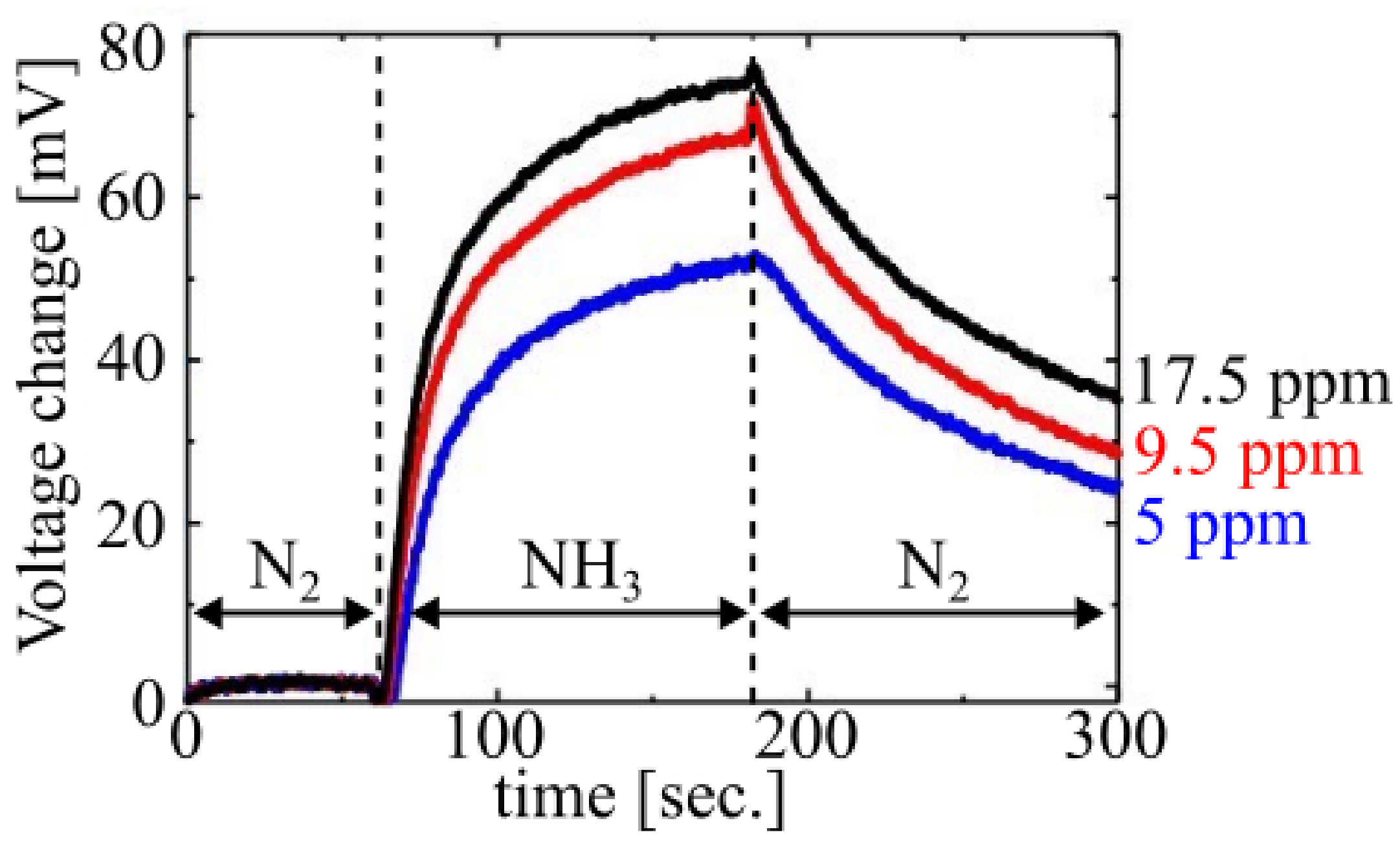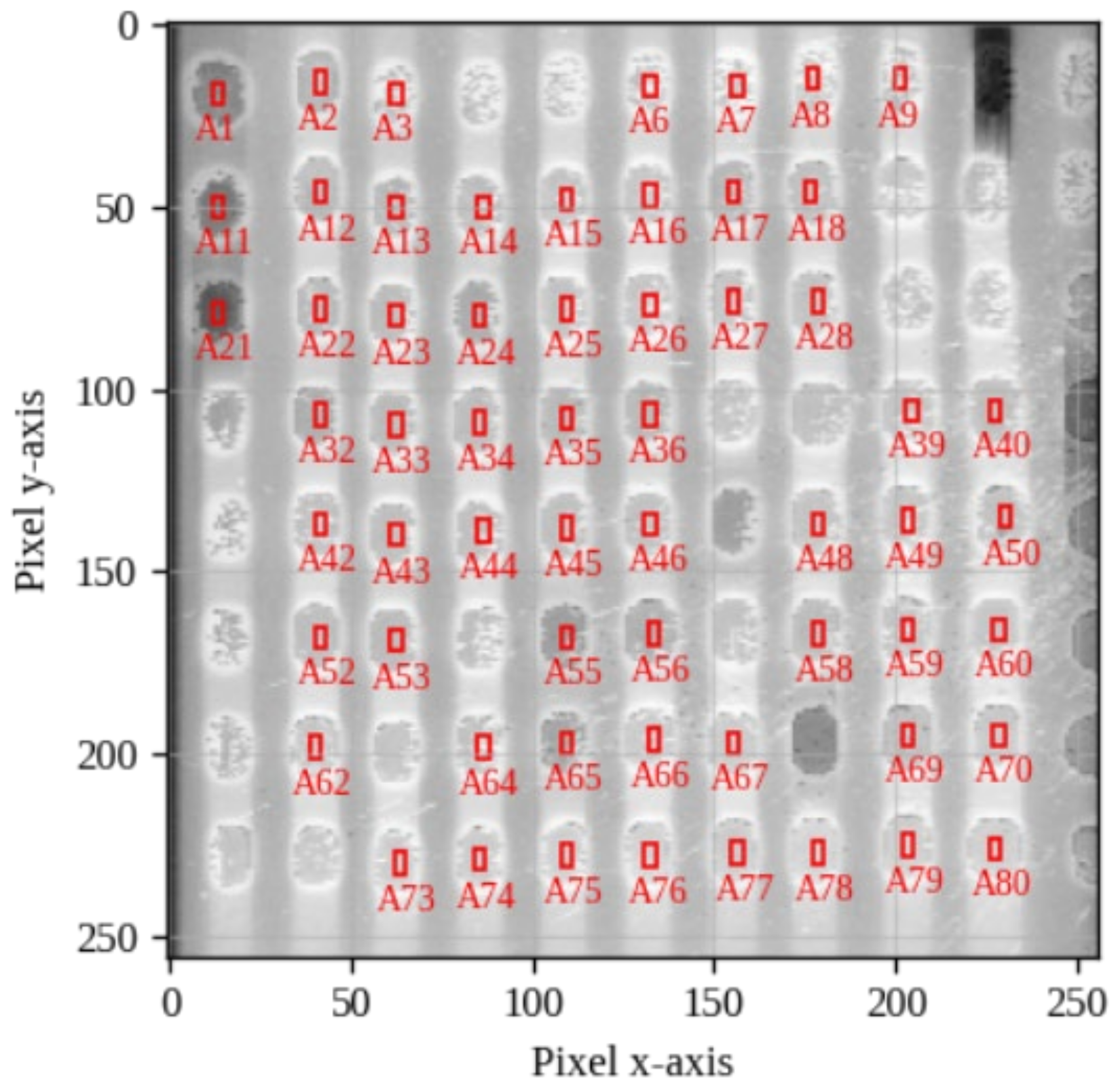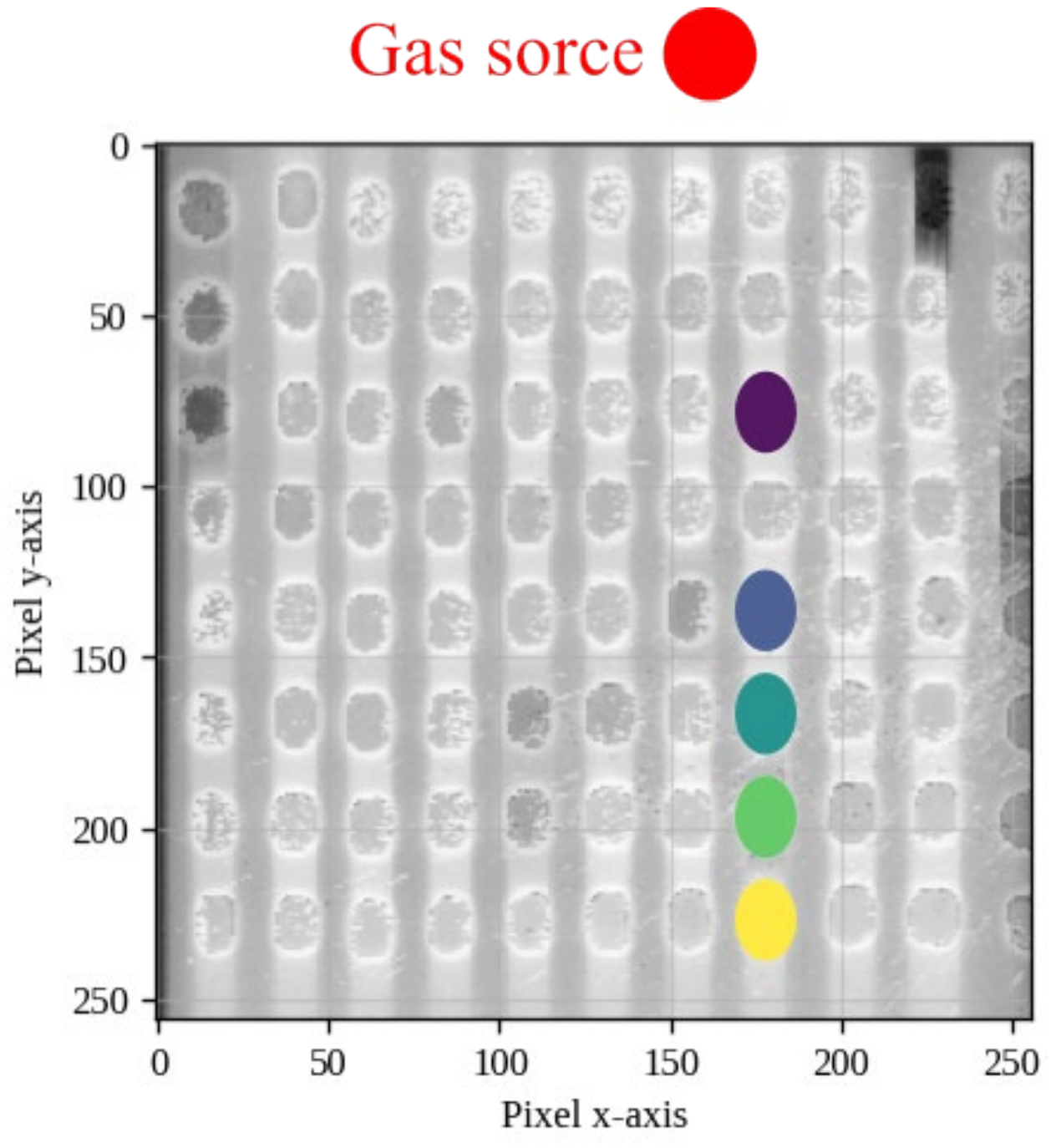Detecting Smell/Gas-Source Direction Using Output Voltage Characteristics of a CMOS Smell Sensor
Abstract
:1. Introduction
2. Directional Estimation System for Locating Smell and Gas Sources
2.1. Principle
2.2. Semiconductor Gas Sensor
2.3. Conventional Method
3. Proposed Directional Estimation System
3.1. CMOS Smell Sensor
3.2. Proposed Sensor
3.3. Proposed Method for Gas-Source Location Direction Estimation
4. Experimental Section
Experimental Methods
5. Results and Discussion
5.1. Results
5.2. Discussion
6. Conclusions
Author Contributions
Funding
Data Availability Statement
Conflicts of Interest
References
- International Campaign to Ban Landmines, Landmine Monitor 2013, 2013/11. OCHA. Available online: https://reliefweb.int/report/world/landmine-monitor-2013 (accessed on 24 November 2023).
- Hunt, J. Rats Save Lives in Landmine-Infested Areas. Available online: https://www.swissinfo.ch/eng/sci-tech/lifesavers-landmines-explosives-rats-cambodia-deadly/44928164#:~:text=Rats%20often%20get%20a%20bad,words%2C%20rats%20save%20many%20lives (accessed on 24 November 2023).
- Takei, Y.; Tashiro, T.; Misawa, T.; Nanto, H.; Kasahara, H.; Iwasaki, Y. Odor Sensor System for Early Fire Detection and Its Application to Utility Mobile Robot. Sens. Mater. 2005, 17, 413–421. [Google Scholar]
- Ishida, H.; Kushida, N.; Yamanaka, T.; Nakamoto, T.; Moriizumi, T. Study of gas/odor flow visualization system using array of pulse drive semiconductor gas sensors. IEEJ Trans. Sens. Micromach. 1999, 199, 194–200. [Google Scholar] [CrossRef]
- Ishida, H.; Yamanaka, T.; Kushida, N.; Nakamoto, T.; Moriizumi, T. Study of real-time visualization of gas/odor flow image using gas sensor array. Sens. Actuators B Chem. 2000, 65, 14–16. [Google Scholar] [CrossRef]
- Csanady, G.T. Wind effects on surface to bottom fronts. J. Geophys. Res. Ocean. 1978, 83, 4633–4640. [Google Scholar] [CrossRef]
- Wu, J.; Zha, J.; Zhao, D.; Yang, Q. Changes in terrestrial near-surface wind speed and their possible causes: An overview. Clim. Dyn. 2018, 51, 2039–2078. [Google Scholar] [CrossRef]
- Taguchi, N. A Metal Oxide Gas Sensor. Japanese Patent S45-38200, 26 October 1962. [Google Scholar]
- Deshmukh, S.; Pandey, R.; Jana, A.; Bhattacharyya, N.; Bandyopadhyay, R. P2. 9.11 Monitoring of obnoxious odorants generated from pulp and paper industry using electronic nose. In Proceedings of the 14th International Meeting on Chemical Sensors—IMCS 2012, Nuremberg, Germany, 20–23 May 2012; pp. 1727–1730. [Google Scholar]
- Dey, A. Semiconductor metal oxide gas sensors: A review. Mater. Sci. Eng. B 2018, 229, 206–217. [Google Scholar] [CrossRef]
- Gebicki, J. Application of electrochemical sensors and sensor matrixes for measurement of odorous chemical compounds. TrAC Trends Anal. Chem. 2016, 77, 1–13. [Google Scholar] [CrossRef]
- Pearce, T.C.; Schiffman, S.S.; Nagle, H.T.; Gardner, J.W. Handbook of Machine Olfaction: Electronic Nose Technology; WILEY-VCH Verlag GmbH & Co. KGaA: Weinheim, Germany, 2002. [Google Scholar]
- Lee, Y.N.; Araki, T.; Kimura, Y.; Dasai, F.; Iwata, T.; Takahashi, K.; Sawasa, K. High-density 2-μm-pitch pH image sensor with high-speed operation up to 1933 fps. IEEE Trans. Biomed. Circuits Syst. 2019, 13, 352–363. [Google Scholar] [CrossRef]
- Hizawa, T.; Sawada, K.; Takao, H.; Ishida, M. Fabrication of a two-dimensional pH image sensor using a charge transfer technique. Sens. Actuator B 2006, 117, 509–515. [Google Scholar] [CrossRef]
- Nakao, M.; Yoshinobu, T.; Iwasaki, H. Scanning-laser-beam semiconductor pH-imaging sensor. Sens. Actuators B 1994, 20, 119–123. [Google Scholar] [CrossRef]
- Milgrew, M.J.; Hammond, P.A.; Cumming, D.R.S. The development of scalable sensor arrays using standard CMOS technology. Sens. Actuators B 2004, 103, 37–42. [Google Scholar] [CrossRef]
- Wada, T.; Choi, Y.J.; Takahashi, K.; Sawada, K.; Noda, T. Verification of basic characteristics of gas sensor using CMOS potential sensor array. In Proceedings of the The Papers of Technical Meeting on “Chemical Sensor”, Shizuoka, Japan, 18–20 November 2022; pp. 45–49. [Google Scholar]
- Nicolas-Debarnot, D.; Poncin-Epaillard, F. Polyaniline as a new sensitive layer for gas sensors. Anal. Chim. Acta 2003, 475, 1–15. [Google Scholar] [CrossRef]
- Pauly, A.; Ali, S.S.; Varenne, C.; Brunet, J.; Llobet, E.; Ndiaye, A.E. Phthalocyanines and Porphyrins/Polyaniline Composites (PANI/CuPctBu and PANI/TPPH2) as Sensing Materials for Ammonia Detection. Polymers 2022, 14, 891. [Google Scholar] [CrossRef] [PubMed]
- Chabukswar, V.V.; Pethkar, S.; Athawale, A.A. Acrylic acid doped polyaniline as an ammonia sensor. Sens. Actuators B Chem. 2001, 77, 657–663. [Google Scholar] [CrossRef]
- Nawaz, A.; Merces, L.; Ferro, L.M.M.; Sonar, P.; Bufon, C.C.B. Impact of Planar and Vertical Organic Field-Effect Transistors on Flexible Electronics. Adv. Mater. 2023, 35, 2370077. [Google Scholar] [CrossRef]
- Zhang, L.; Jin, Y.; Lin, L.; Li, J.; Du, Y. The comparison of CCD and CMOS image sensors. In Proceedings of the 2008 International Conference on Optical Instruments and Technology: Advanced Sensor Technologies and Applications, Beijing, China, 16–19 November 2008; Volume 7157. [Google Scholar]
- Shi, C. Applications of CMOS image sensors: Applications and innovations. Appl. Comput. Eng. 2023, 11, 95–103. [Google Scholar] [CrossRef]
- Matsunashi, J. Environmental Fluid Transport (Kankyo Ryutai Yusou); The Nikkan Kogyo Shimbun: Kogyo, Japan, 1991; pp. 1–9. [Google Scholar]
- Murlis, J.; Elkinton, J.S.; Carde, R.T. Odor plumes and how insects use them. Annu. Rev. Entomol. 1992, 37, 505–532. [Google Scholar] [CrossRef]
















Disclaimer/Publisher’s Note: The statements, opinions and data contained in all publications are solely those of the individual author(s) and contributor(s) and not of MDPI and/or the editor(s). MDPI and/or the editor(s) disclaim responsibility for any injury to people or property resulting from any ideas, methods, instructions or products referred to in the content. |
© 2024 by the authors. Licensee MDPI, Basel, Switzerland. This article is an open access article distributed under the terms and conditions of the Creative Commons Attribution (CC BY) license (https://creativecommons.org/licenses/by/4.0/).
Share and Cite
Asada, Y.; Maeno, K.; Hashizume, K.; Yodo, Y.; Noda, T.; Sawada, K.; Akiyama, M. Detecting Smell/Gas-Source Direction Using Output Voltage Characteristics of a CMOS Smell Sensor. Electronics 2024, 13, 1847. https://doi.org/10.3390/electronics13101847
Asada Y, Maeno K, Hashizume K, Yodo Y, Noda T, Sawada K, Akiyama M. Detecting Smell/Gas-Source Direction Using Output Voltage Characteristics of a CMOS Smell Sensor. Electronics. 2024; 13(10):1847. https://doi.org/10.3390/electronics13101847
Chicago/Turabian StyleAsada, Yoshihiro, Kenichi Maeno, Kenichi Hashizume, Yusuke Yodo, Toshihiko Noda, Kazuaki Sawada, and Masahiro Akiyama. 2024. "Detecting Smell/Gas-Source Direction Using Output Voltage Characteristics of a CMOS Smell Sensor" Electronics 13, no. 10: 1847. https://doi.org/10.3390/electronics13101847



